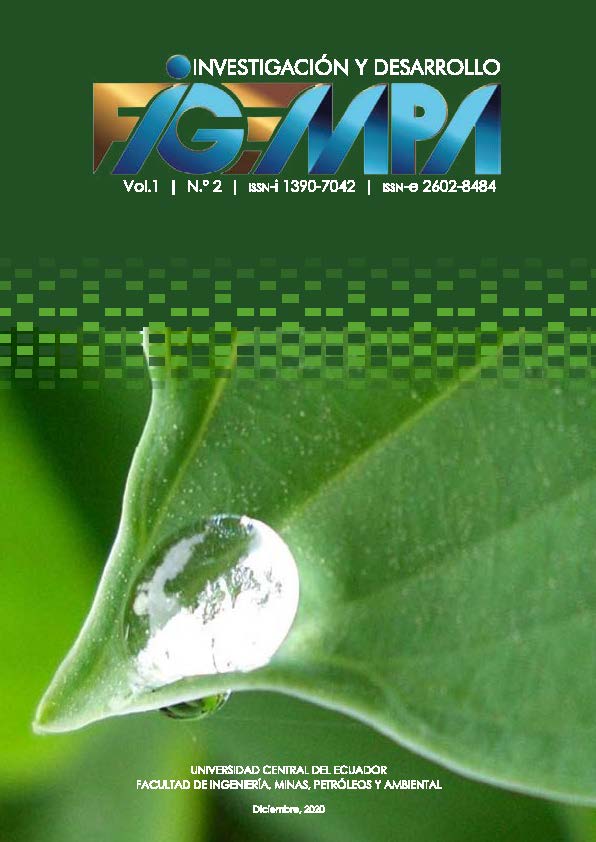Experimental study of application of conventional SAGD compared with SAGD using additives (CO2 and enzyme) for the recovery of extra-heavy crude from Pungarayacu field
Main Article Content
Abstract
The Pungarayacu field contains the largest extra-heavy oil accumulation, approximately 4.6 billion barrels of OOIP, so this hydrocarbon due to its very high viscosity don´t tend to move easily through the porous medium towards the well. To improve its mobility ratio, decreasing its viscosity, a possible effective thermal method for the hydrocarbon to move towards the well is steam assisted gravity drainage (SAGD). In the present study, a physical model was designed and built to evaluate SAGD, trying to simulate parameters such as: pressure, temperature and reservoir rock characteristics; two types of experiments were carried out: conventional SAGD y SAGD with additives (GreenZyme and CO2). The experiments were carried out at relatively low and high pressures to evaluate the impact of the pressure, the measurements made were: volume of hydrocarbon produced, recovery factor and the steam injection ratio. The measured parameters allowed to evaluate and compare the feasibility of using a conventional SAGD method or a SAGD method with additives for the reservoir. In the physical model, six displacement tests were carried out knowing that conventional SAGD is an efficient thermal process to recover the oil trapped in heavy and extra-heavy oil reservoirs. When applying the conventional SAGD method with the inclusion enzyme (GreenZyme) in the experimentation carried out, the recovered crude was 60%. In the experiments carried out in this study, it is evident that adding CO2 don’t get the desire based on its solubility, due to the expansion of the gas that cools the system. More experiments are required to evaluate the impact of adding CO2 in a SAGD process based on field conditions.
Downloads
Metrics
Article Details

This work is licensed under a Creative Commons Attribution-NonCommercial 4.0 International License.
References
Alboudwarej, H., Badry, R. y Baker, A. (2006) La importancia del petróleo pesado, Oilfield Review.https://www.slb.com/-/media/files/oilfield-review/heavy-oil-3-spanish
Baby, P., Rivadeneira, M. y Barragán, R. (2004) La cuenca Oriente: geología y petróleo. Convenio ifea, ird, Petroproducción, pp. 295.
Cortez, S. y Lema, C. (2019) Evaluación de un modelo físico experimental de la técnica de SAGD combinada con aditivos para la recuperación de crudo pesado del campo Pungarayacu (Tesis de maestría). http://www.dspace.uce.edu.ec/handle/25000/20578
Dorador, E. y González. I. (2014) Nuevas tecnologías aplicadas a sagd para mejorar la recuperación de hidrocarburos (Tesis de pregrado). https://repositorio.unam.mx/contenidos/nuevas-tecnologias-aplicadas-a-sagd-para-mejorar-la-recuperacion-de-hidrocarburos-114238?c=4M0YGP&d=false&q=*:*&i=2&v=1&t=search_0&as=0
Ivanhoe Energy and the Pungarayacu Project in Ecuador (2011) Ivanhoe Risk Assessment. https://amazonwatch.org/assets/files/2011-ivanhoe-energy-in-ecuador.pdf
Lowy. D. (2014) Estudio técnico de la predicción máxima de extracción y demás variables operacionales que intervienen en el proceso de producción de crudos pesados y extrapesados por segregación gravitacional asistida por vapor (SAGD), utilizando datos del campo Pungarayacu (Tesis de pregrado). Recuperado de http://repositorio.ute.edu.ec/handle/123456789/14365
Males, C. y Miranda, G. (2017) Modelo de simulación matemática para la producción del campo Pungarayacu- bloque 20 (Tesis de pregrado). http://www.dspace.uce.edu.ec/handle/25000/13351
Ministerio de Recursos Naturales No Renovables. (2014) Información sector petróleo y gas Ecuador. https://www.academia.edu/9186034/Ministerio_de_Recursos_Naturales_No_Renovables
Torres, C. (2018) Estudio comparativo de los métodos de recuperación mejorada SAGD y vapex en el campo Pungarayacu mediante software de ingeniería (Tesis de pregrado). https://repositorio.upse.edu.ec/bitstream/46000/4781/1/upse-tip-2019-0004.pdf

